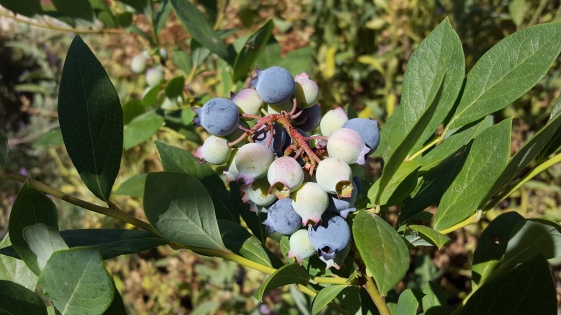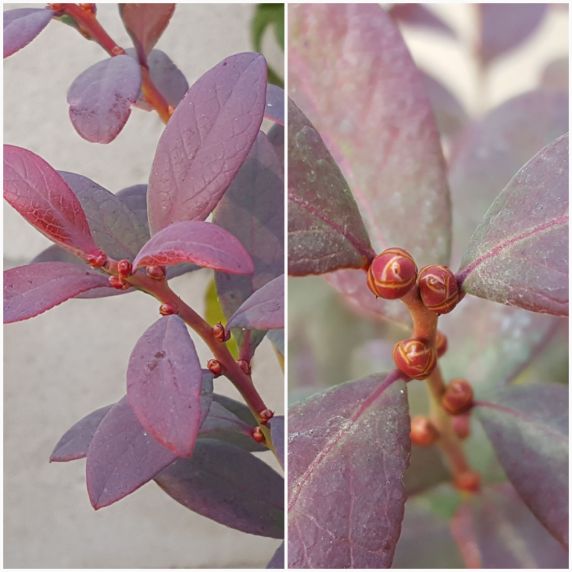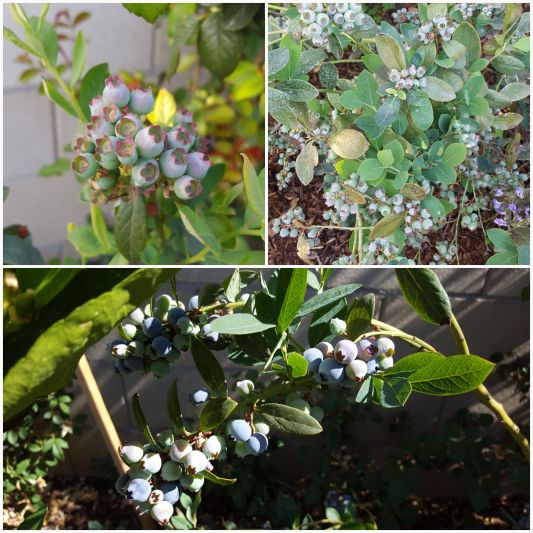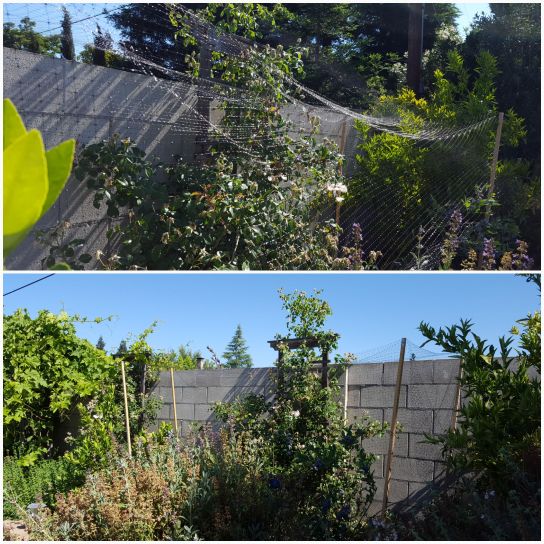 When I think of growing blueberries, I think of places like Oregon or Maine. You know, forests and cooler climates. Not 100+ F temperatures in California’s Central Valley zone 9. Yet, here they are!
When I think of growing blueberries, I think of places like Oregon or Maine. You know, forests and cooler climates. Not 100+ F temperatures in California’s Central Valley zone 9. Yet, here they are!
 When I was thinking of plants I wanted in my garden, I spent a lot of time lamenting the fact that many of them just weren’t going to thrive here. I hear a lot about gooseberries and huckleberries, even cranberries. Not one of them will really make it with our hot summers and mild winters. I had consigned myself to not being able to grow blueberries, either, but then I found out that there are actually many varieties that can take the heat and have low chill hour requirements. YIPPEE!!!!
When I was thinking of plants I wanted in my garden, I spent a lot of time lamenting the fact that many of them just weren’t going to thrive here. I hear a lot about gooseberries and huckleberries, even cranberries. Not one of them will really make it with our hot summers and mild winters. I had consigned myself to not being able to grow blueberries, either, but then I found out that there are actually many varieties that can take the heat and have low chill hour requirements. YIPPEE!!!!
*A handy growing summary chart is at the end of the article.*
(All links open a new page, so you won’t lose your spot when you look around! Get information on gardening and cultural traditions, recipes, stories, and more!)

There are five main categories of blueberries: lowbush, Northern highbush, Southern highbush, rabbiteye, and half-high. What you normally find in the store will be some type of Northern highbush. Their names give you a pretty good idea of their growth habit, but there is much more you need to know to select the right one for your garden. Lowbush: As the name implies, these grow lower to the ground, roughly 1 1/2 feet high. They are not self-fertile, so you will need at least one other variety to ensure cross-pollination. They prefer the cooler climates of zones 4-7.
Lowbush: As the name implies, these grow lower to the ground, roughly 1 1/2 feet high. They are not self-fertile, so you will need at least one other variety to ensure cross-pollination. They prefer the cooler climates of zones 4-7.
Northern Highbush: The name says it, native to the northern (and eastern) U.S., and grows tall. They can reach 6-9 feet in height, so occasional pruning will help keep them under control and will actually help productivity. They prefer the cooler climates of zone s 4-7. They don’t require a pollinator, but will be more productive if at least one other variety is present nearby.
Southern Highbush: Again, the name gives it away. They are native to the southern portions of the U.S. and have a much lower chill hour requirement. This means that they will grow in warmer zones that don’t have really cold winters and can take hot summers. They are often compatible with zones 5-10. Like their northern “relatives”, they grow tall-ish, 4-6 feet, and will benefit from pruning to keep them bushier and more productive. They, too, will have a better crop if another variety is grown, but they are technically self-fertile. I have Southmoon and Misty in my yard, and both provide bountiful harvests of tasty treats. Rabbiteye: These are also native to the southern parts of the U.S. like the southern highbush berries, but the rabbiteyes are not as tolerant of the cold. They are better suited for zones 7+ as a result. These grow very tall, 6-10 feet, and also require another variety for cross pollination. This type is also more seedy with tougher skins than the other varieties. I have heard mixed reviews of their flavor, so you may want to taste test before buying them for your garden.
Rabbiteye: These are also native to the southern parts of the U.S. like the southern highbush berries, but the rabbiteyes are not as tolerant of the cold. They are better suited for zones 7+ as a result. These grow very tall, 6-10 feet, and also require another variety for cross pollination. This type is also more seedy with tougher skins than the other varieties. I have heard mixed reviews of their flavor, so you may want to taste test before buying them for your garden.
Half-High: These are hybrids between highbush and lowbush plants, and so grow half as high! Roughly 3-4 feet, and not needing as much pruning as their taller counterparts. They are not self-fertile, so you will need more than one variety to get fruit set. They are more cold tolerant and prefer zones 3-7.
Growing Information:
All blueberries, regardless of variety, require loose soil that is acidic. They will die (forget not thriving, just straight up dead) even if the soil is mildly acidic because that’s just not acidic enough. You will need to aim for a pH of 4.5-5.5. There are a variety of ways in which you can test your soil and amend it to ensure proper acidity. However, it is best to prepare the soil from the beginning for best results. It is recommended that when planting your blueberries that you dig a rather large hole and fill it with quality soil highly enriched with compost. This will ensure that the soil is loose and has the organic components that will create acidity right off the bat. This is really essential if your soil is heavier and/or has a higher pH. You will need to continue to amend the soil to maintain that lower pH after the plants are in the ground. Irrigation water often raises pH and will cause your plants to struggle to survive. You can find multiple types of fertilizers and soil acidifiers specifically for acid loving plants, or you can do what I do and make your own practically for free from items you may already have! Read my article on soil-acidifiers for more information.
You will need to continue to amend the soil to maintain that lower pH after the plants are in the ground. Irrigation water often raises pH and will cause your plants to struggle to survive. You can find multiple types of fertilizers and soil acidifiers specifically for acid loving plants, or you can do what I do and make your own practically for free from items you may already have! Read my article on soil-acidifiers for more information.

Blueberries prefer full sun, but can take some shade during the day. They are not drought tolerant, so be sure to provide adequate water. Mulching the ground will help retain moisture and cool the soil, as well as helping keep the pH of the soil lower. The berries are ripe usually between May and July, depending on the variety. Regular harvesting will help later berries develop in size and flavor. Be prepared to protect your berries from hungry marauders! Our biggest threat is from birds, but other visitors may also want a nibble or two.
Plant Summary:
- Perennial: may live up to 15+ years
- Deciduous
- Height: depends on variety, 1-10+ feet
- Width: depends on variety, usually matches potential height
- Sun: full sun, can tolerate some morning or afternoon shade
- Water: do not let roots get dry
- Soil pH: 4.5-5.5, acidic
- Soil type: needs loose, well amended soil
- Key nutrients: balanced, be sure to monitor pH
- Planting time: best to start in cool spring after freeze danger has passed


Sadly, nurseries here still sell the same varieties that are sold in Oregon, just because people continue to buy them to replace the plants from the previous year that did not survive! Those that do well here are only now starting to gain popularity. I happen to dislike them anyway, so it does not matter in my garden. We do have the native huckleberry, but they are not very productive.
LikeLiked by 1 person
I’ve only seen the Southern highbush varieties here, and they are seeming to sell out each year. In fact, there is a blueberry farm not too far out of town now and they sell at some of the farmer’s markets. We love them, especially since we can get them fresh from the back yard!
LikeLiked by 1 person
Wow, that is crazy; a blueberry farm in your region! I suppose it makes sense where fresh blueberries are unavailable. They do not transport easily when ripe. Ripe blueberries here are probably like ripe apricots in Maine. Yes, they can get them, but they are not the same thing.
LikeLiked by 1 person